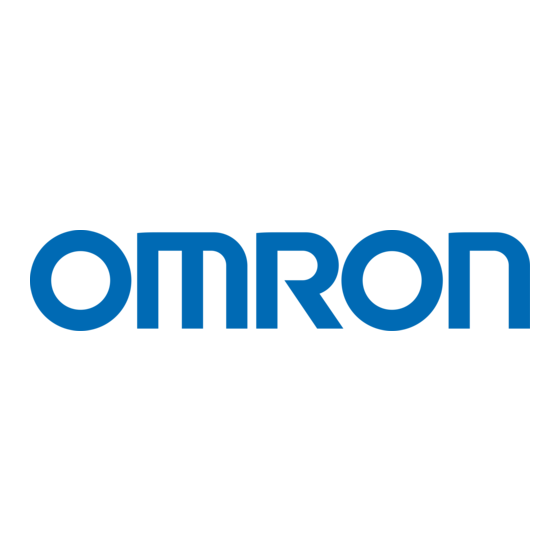
Table of Contents
Advertisement
Quick Links
Optical Fiber Glossy Object Sensor
E3X-NL
Employs OMRON's unique FAO (Free Angle Optics)
technology which enables delicate sensing of object
glossiness without influence from colors and patterns.
Transparent films on boxes and labels on transparent films
can be detected.
Short-range small spot
The teaching system ensures easy adjust-
ment just by pressing the button.
● Adjustment man-hour saving
type requiring only a one-time
pressing of the button
● Teaching system only re-
quires to push the button, en-
suring sensitivity adjustment
without individual differences.
E3X-NL
Utilization lightwave technology has inno-
vated glossiness detection. OMRON's
glossy object sensor can discriminate a
wide variety of glossiness differences. The
fiber-optic system has achieved the small,
non-contact models.
Features
Long-range
Two different types of fiber heads meet a wide range
of applications.
Two different fiber heads are available.
According to applications, you can choose the short-distance,
small spot type ideal for detection of small objects or the long-
distance type that can perform in-line standard detection.
Short-distance, small spot type
E32-S15-1/-2
Ideal for precision detection
and small object detection.
Adopts the pulse-ON system that is insensi-
tive to disturbance light
The emitter (red LED) in the fiber head uses a pulse-ON
system to minimize the influence of disturbance light. The
Sensor provides stable sensing characteristics if disturbance
light occurs from fluorescent lamps in-line.
Long-distance type
E32-S15L-1/-2
Resistant to object shake and
enables in-line standard detec-
tion.
Amplifier Units
E3X-NL11
A-197
Advertisement
Table of Contents

Summary of Contents for Omron E3X-NL
- Page 1 Transparent films on boxes and labels on transparent films According to applications, you can choose the short-distance, can be detected. small spot type ideal for detection of small objects or the long- distance type that can perform in-line standard detection. Short-distance, small spot type...
- Page 2 S wave: vertical transparent film 45 ˚ P wave: parallel Sensing head The object can be sensed smoothly when the angle of the sensing head is either 0 ˚ or 45 ˚ . A-198 Standard Photoelectric Sensors...
-
Page 3: Ordering Information
Shape Model Quantity Remarks Can be used with the fiber unit E32-S15-#. Mounting bracket vari- able in rotary angle (0°, 45°) for sta- E39-L109 ble detection of transparent films (double-refractive objects) on glossy objects such as metal or glass plates. - Page 4 Remote teaching input and blue (0 V) are disconnected when remote input turns OFF: Open or 9 V min. (max. input voltage 24 V). Note that the input is valid only when remote RUN/TEACH selection input (across pink-blue) is provided.
-
Page 5: Output Circuit Diagram
Characteristic data (typical) Glossiness vs. Operating Range (Typical) Glossiness vs. Angle (Typical) E3X-NL11 with E32-S15-# E3X-NL11 + E32-S15-# (X direction) E3X-NL11 + E32-S15L-# (X direction) Sensing object: 40 x 20 mm Sensing object: Sensing object: 40 ¥ 20 mm 40 ¥ 20 mm... -
Page 6: Technical Guide
Glossiness of Typical Object Sensed by E3X-NL11 + E32- 1,000 The object can be sensed smoothly when the angle of the sensing head is either 0 ˚ or 45 ˚ . Fuzzy Teaching Function E3X-NL in two-point teaching operation will perform fuzzy computation using the difference in glossiness and the differ- 1. -
Page 7: Operation
Locate the sensor head within the sensing Move the mode selector to the TEACH distance. position. TIMER Press the teaching button with one of the TEACH Move the mode selector to the TEACH sensing objects or the background object position. - Page 8 Installation Tightening Force Two-point Teaching and One-point Teaching Refer to the following information to select the most suitable For the fiber unit installation, tighten it to the torque of 0.3 Nm sensitivity setting method for the application. max. Sensitivity Two-point teaching...
- Page 9 (If teaching is NG.) The following signal conditions must be given as remote teaching input conditions. * Note: T1 must be 20 ms minimum and T2 must be 500 ms minimum at the time of remote teaching. (Remote 1-point teaching) Brown + V T2 * 1.0 to 1.3s...
-
Page 10: Dimensions (Unit: Mm)
Accessories (Order Separately) ALL DIMENSIONS SHOWN ARE IN MILLIMETERS. To convert millimeters into inches, multiply by 0.03937. To convert grams into ounces, multiply by 0.03527. Cat. No. E248-E2-02-X In the interest of product improvement, specifications are subject to change without notice.














Need help?
Do you have a question about the E3X-NL and is the answer not in the manual?
Questions and answers